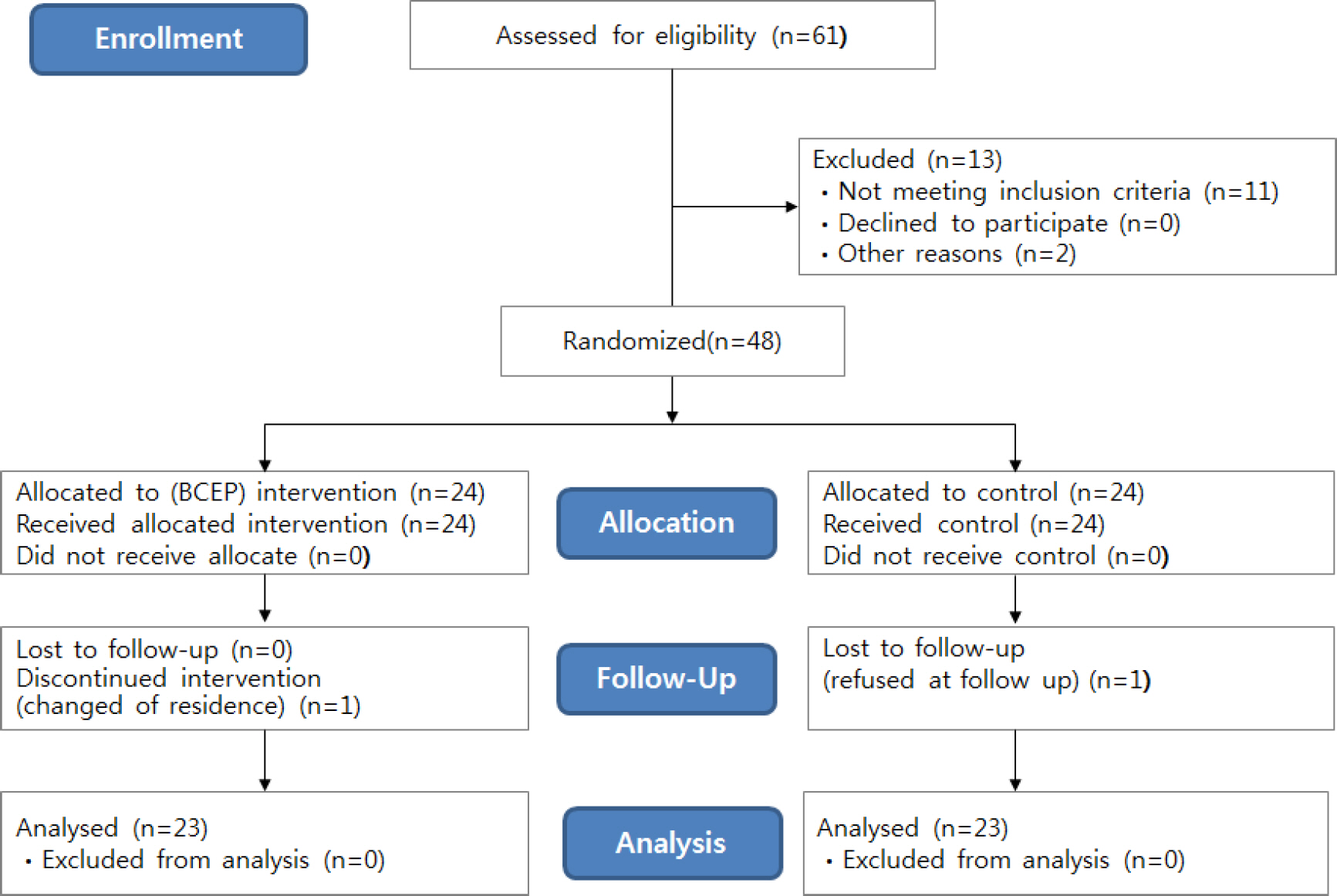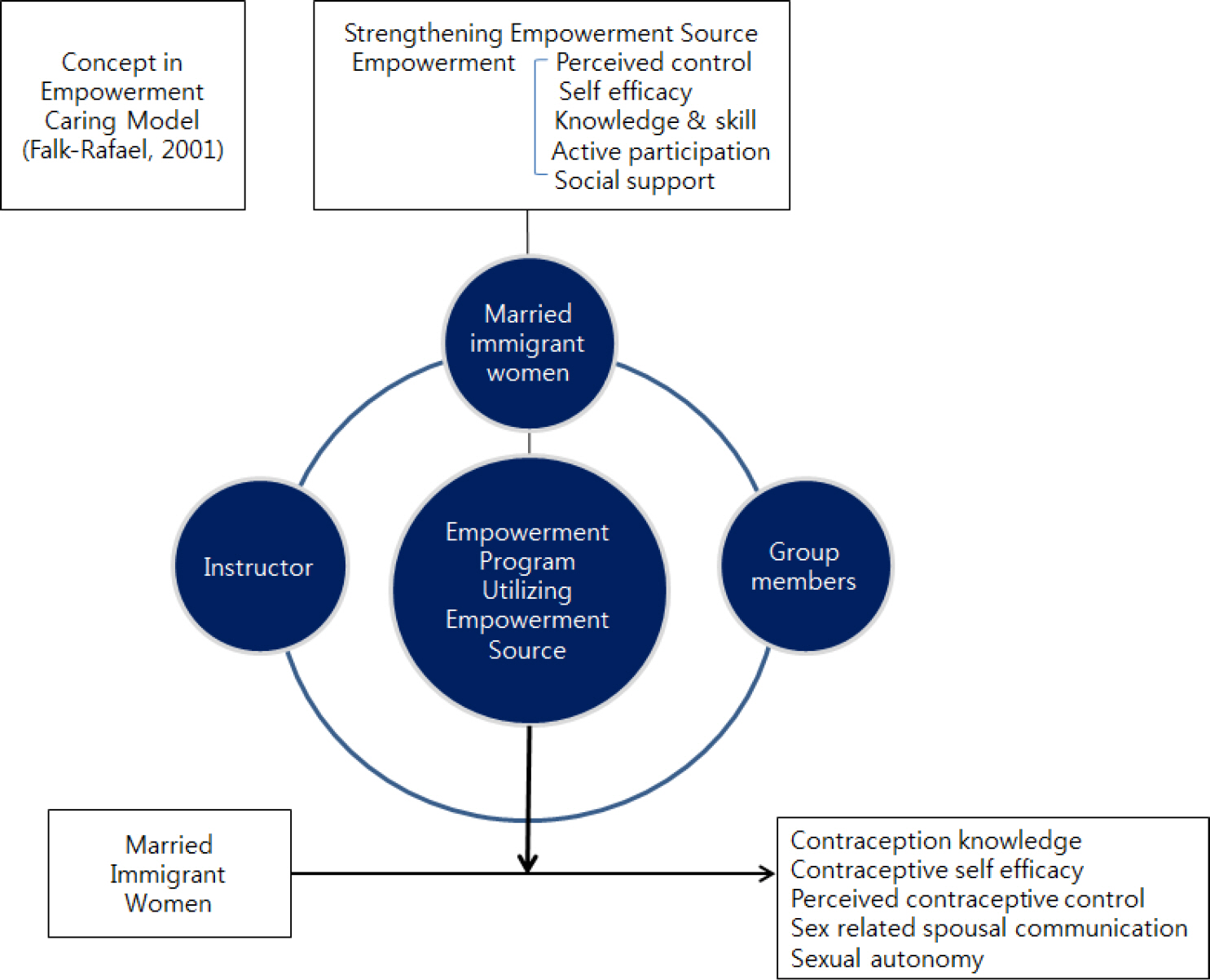Korean J Women Health Nurs.
2017 Mar;23(1):1-10. 10.4069/kjwhn.2017.23.1.1.
Effects of Birth Control Empowerment Program for Married Immigrant Vietnamese Women in South Korea
- Affiliations
-
- 1Department of Nursing, Daejeon University, Daejeon, Korea.
- 2College of Nursing, The Catholic University of Korea, Seoul, Korea. jheyeline@hanmail.net
- KMID: 2449860
- DOI: http://doi.org/10.4069/kjwhn.2017.23.1.1
Abstract
- PURPOSE
Aims of the researchers were to develop an birth control empowerment program (BCEP) designed to help married immigrant women in Korea to plan their pregnancies.
METHODS
This study was as a randomized controlled trial to verify the effects of the BCEP. The BCEP was developed based on Falk-Rafael (2001)'s Empowerment caring model. The program was offered once a week, for 90 minutes per session, for a total of 10 weeks. The BCEP incorporated group instruction, group discussion, and counseling. The eligible participants were randomly assigned to either experimental group (n=23) or control group (n=23).
RESULTS
Participants in the intervention group had significantly better outcomes in contraceptive knowledge (p<.001), contraceptive self-efficacy (p=.014), perceived contraceptive control (p<.001), sex-related spousal communication (p<.001), and sexual autonomy (p=.009).
CONCLUSION
The BCEP was effective intervention method, which can promote family planning practices among married immigrant women.
Keyword
MeSH Terms
Figure
Cited by 1 articles
-
Intervention for Married Immigrant Women in Korea: A Systematic Review
Soo Jin Lee, Xianglan Jin, Sujin Lee
J Korean Soc Matern Child Health. 2021;25(2):99-108. doi: 10.21896/jksmch.2021.25.2.99.
Reference
-
1. Statistic Korea. Research situation analysis of foreign population [internet]. Seoul: Author;2016. [cited 2016 July 16]. Available from:. http://kostat.go.kr/.2. Jung GH, Koh HJ, Kim KS, Kim SH, Kim JH, Park JH, et al. A survey on health management of during pregnancy, childbirth, and the postpartum of immigrant women in a multicultural family. Korean Journal of Women Health Nursing. 2009; 15(4):261–269.3. Choi JH, Kim KE, Shin MA. Contraceptive knowledge, contraceptive attitude, and contraceptive use among college students: Function of gender, age, and residence. Korean Journal of Human Ecology. 2010; 19(3):511–522.
Article4. Kim TI, Kim JY, Jung GH, Choi SM. Contraceptive knowledge and practice among married immigrant women. Korean Journal of Women Health Nursing. 2012; 18(4):290–301.
Article5. Bensyl DM, Iuliano DA, Carter M, Santelli J, Gilbert BC. Contraceptive use-United States and territories, Behavioral Risk Factor Surveillance System. Morbidity and Mortality Weekly Report. 2005; 54(6):1–72.6. Shin NY, Kang YH. The relationships among health locus of control and resilience, social support and health promoting behavior in patients with newly diagnosed coronary artery diseases. Korean Journal of Adult Nursing. 2015; 27(3):294–303.
Article7. Teerawichitchainan B, Amin S. The role of abortion in the last stage of fertility decline in Vietnam. International Perspectives on Sexual and Reproductive Health. 2010; 36(2):80–89.
Article8. Kim MK, Lee HR, Kwon JY, Oh HS. Influencing and mediating factors in health behaviors among stroke patients. Korean Journal of Adult Nursing. 2013; 25(6):610–621.
Article9. Kim MJ, Kang HS. A Comparative study of consistent and inconsistent contraceptive users on partner communication, perceived contraceptive control, and sexual autonomy. Journal of Korean Academy of Nursing. 2003; 33(6):784–791.
Article10. Falk-Rafael AR. Empowerment as a process of evolving consciousness: A model of empowered caring. Advance in Nursing Science. 2001; 24(1):1–16.
Article11. Blanc AK. The effect of power in sexual relationships on sexual and reproductive health: An examination of the evidence. Studied in Family Planning. 2001; 32(3):189–213.
Article12. Yoo MS. Effects of a multicultural marital advocacy program based on empowerment model on self-Esteem, self-Efficacy, coping way and family stress in multicultural couples. Journal of Korean Society of Maternal and Child Health. 2010; 14(2):145–160.13. Cohen J. Statistical power analysis for the behavioral science. 2nd ed.Hillsdale, NJ: Lawrence Erlbaum Associates;1988. p. 400.14. Bandura A. Self-efficacy mechanism in human agency. American Psychologist. 1982; 37(2):122–147.
Article15. Hwang SW, Chung CW. Contraception behavior and related factors in unmarried female and male. Korean Journal of Women Health Nursing. 2011; 17(1):77–87.
Article16. Yeon YR, Yang S. Effects of a marital relationship enrichment program on communication, conflict resolution, and marital satisfaction in multicultural couples. Journal of Korean Academy Psychiatric and Mental Health Nursing. 2012; 21(3):250–261.17. Crawford Shearer NB, Fleury JD, Belyea M. Randomized control trial of the health empowerment intervention: Feasibility and impact. Nursing Research. 2010; 59(3):203–211.18. Eo YS. Effects of an empowerment program on the burden of mothers having a child with cerebral palsy. Journal of Korean Academy of Nursing. 2005; 35(1):154–164.
Article19. Choi JS, Oh JY. A Study on group art activity program for empowerment of the female marriage immigrants. Korean Journal of Family Social Work. 2011; 33:319–347.20. Kim TI, Kim MJ, Kim JH. Pregnancy, childbirth, parenting (p. 128-162) contraception. Seoul: Jongmin;2012.21. Kim M. A structural equation model explaining contraception behaviors of married Korean women. Korean Journal of Women Health Nursing. 2001; 7(2):141–156.22. Kang HS. An explanatory model of condom use among Korean college students [dissertation]. Seoul: Yonsei University;2001. p. 121.23. Galavotti C, Cabral RJ, Lansky A, Grimley DM, Riley GE, Pro-chaska JO. Validation of measures of condom and other contraceptive use among women at high risk for HIV infection and unintended pregnancy. Health Psychology. 1995; 14(6):570–278.24. Calabretto H. Emergency contraception- knowledge and attitudes in a group of Australian university students. Australian and New Zealand Journal of Public Health. 2009; 33(3):234–239.25. Wang RH, Wang HH, Hsu MT. Factors associated with adolescent pregnancy- a sample of Taiwanese female adolescents. Public Health Nursing. 2003; 20(1):33–41.
Article26. Baffour TD, Chonody JM. Do empowerment strategies facilitate knowledge and behavioral change? The impact of family health advocacy on health outcomes. Social Work in Public Health. 2012; 27(5):507–519.
Article27. Skaff MMK, Mullan JT, Fisher L, Chesla CA. A contextual model of control beliefs, behavior, and health: Latino and European Americans with Type 2 diabetes. Psychology and Health. 2003; 18(3):295–312.
Article28. McFarlane J, Malecha A, Watson K, Gist J, Batten E, Hall I, et al. Intimate partner sexual assault against women: Frequency, health consequences, and treatment outcomes. Obstetrics and Gynecology. 2005; 105(1):99–108.
Article29. Crissman HP, Adanu RM, Harlow SD. Women's sexual empowerment and contraceptive use in Ghana. Studies in Family Planning. 2012; 43(3):201–212.
Article
- Full Text Links
- Actions
-
Cited
- CITED
-
- Close
- Share
- Similar articles
-
- Action Research for Parent Empowerment of Married Immigrant Women
- Effects of a Customized Birth Control Program for Married Immigrant Postpartum Mothers
- Maternal Conflicts of Vietnamese Married Immigrant Women in Korea
- Influence of Spousal Support on the Relationship between Acculturative Stress and Sense of Parenting Competence among Married Vietnamese Immigrant Women
- The Health Management Experience of Vietnamese Married Immigrant Women Living in the City



